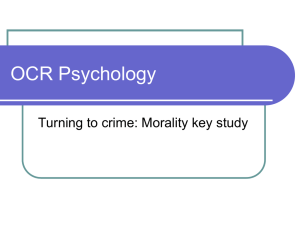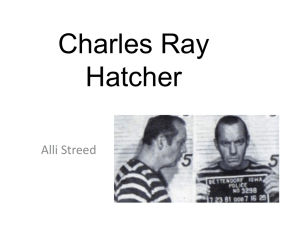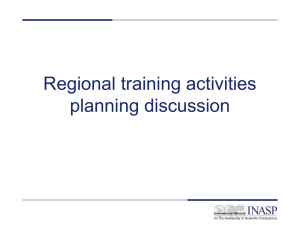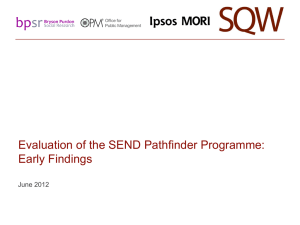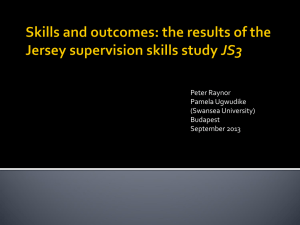Introduction to Assessment and Treatment of Offenders Dr. Ruth
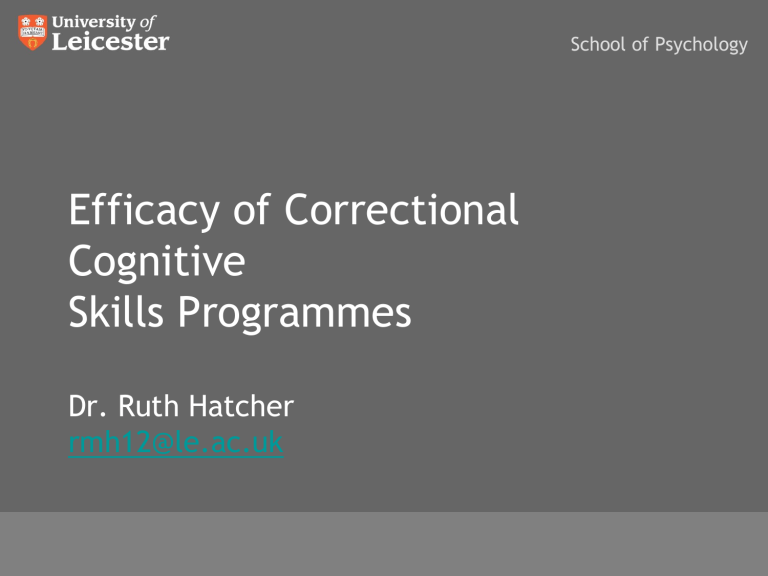
Efficacy of Correctional
Cognitive
Skills Programmes
Dr. Ruth Hatcher rmh12@le.ac.uk
www.le.ac.uk
School of Psychology
What are cognitive skills programmes?
• Interventions for offenders
• Based in
– prison (voluntary) and
– community (court mandated)
• Group work programmes with offenders
• Typically 50-100 hours of intervention
• Based on cognitive-behavioural principles
What are cognitive skills programmes?
• Aim to change behaviour
– reduce likelihood of subsequent reconviction
• Address social cognitive deficits associated with offending
– Impulse control, emotional regulation, consequential thinking, and problem-solving skills
• Help offenders develop pro-social skills
– “help offenders solve problems and make personal decisions more effectively by helping offenders learn
how, rather than what, to think” (Travers, Mann, &
Hollin, 2014)
• Also serve a punitive function
– “A fine on time” (Rex & Gelsthorpe, 2002)
Cognitive skills programmes in practice
• General offending:
– Enhanced Thinking Skills (ETS),
– Reasoning and Rehabilitation (R&R)
– Think First
– Thinking Skills Programme (TSP)
– Priestley One to One
• Offence specific:
– Community Sex Offender Group Programme (C-SOGP)
– Controlling Anger and Learning to Manage it (CALM)
– Integrated Domestic Abuse Programme (IDAP)
– Addressing Substance Related Offending (ASRO or P-ASRO)
– Lower Intensity Alcohol Programme (LIAP)
Origins of cognitive skills programmes
• Two distinct areas of research:
1. Research into cognitive functioning of offenders
– Offenders have distinct thinking styles (Ross &
Fabiano, 1985)
2. Meta-analytic research
– Remarkably consistent findings
– Findings condensed into the
• Risk-Need-Responsivity model of correctional service
(Andrews, Bonta, & Hoge, 1990), and
• Correctional Services Accreditation Criteria (Lipton, et al.,
2000; Maguire et al., 2010)
Developing and maintaining good practice:
Accreditation
Are cognitive skills programmes effective?
• Outcome research
• Focus on data from England and Wales
– Community
– Prison
• Focus on general offending behaviour programmes
Outcome Research: Pathfinder Evaluation
• Dataset = 4935 community based offenders
– Treatment group = 2186
• Think First
• Enhanced Thinking Skills (ETS)
• Reasoning and Rehabilitation (R&R)
– Comparison group = 2749
• At Census point
– 65.6% of total sample of 4935 were reconvicted
Hollin et al. (2008)
Outcome Research: Pathfinder Evaluation
Treatment group – 66.64%
Comparison group – 64.79%
Hollin et al. (2008)
Outcome Research: Pathfinder Evaluation
• However, early implementation suffered from high levels of attrition from programmes:
– 28.2% completed
– 23.3% started but failed to complete (non-completers)
– 48.5% didn’t start (non-starters)
Hollin et al. (2008)
Outcome Research: Pathfinder Evaluation
Completers– 39.8%
Non-completers–75.3%
Non-starters– 78.0%
Comparison– 64.8%
Hollin et al. (2008)
Outcome Research: Pathfinder Evaluation
• Completers
– 38.7% less likely to be reconvicted than the Comparison group
– 66.8% less likely to be reconvicted than the Non Completers
– 70.9% less likely to be reconvicted than the Non Starters
• Non Completers
– 100% more likely to be reconvicted than the Comparison group
• Non Starters
– 130.9% more likely to be reconvicted than the Comparison group.
Hollin et al. (2008)
Outcome Research: Pathfinder Evaluation
“Overall, the evidence suggests that compared to no-treatment controls, there is a positive effect on reconviction of program completion but a higher rate of reconviction for program noncompleters”
Hollin et al. (2008)
Outcome Research: Pathfinder Evaluation
• Non-completion effect
– Evidence that non-completers perform worse than appropriate comparison groups
• At what point in the programme does the cross over happen?
• Non-completers categorised into quintiles
– Based on their point of dropout (i.e. percentage of programme completed)
• Seven groups:
– Comparison
– Quintile 1 (1%-19% completed)
– Quintile 2 (20%-39% completed)
– Quintile 3 (40%-59% completed)
– Quintile 4 (60%-79% completed)
– Quintile 5 (80-99% completed)
– Completers
Hatcher, et al, in preparation
Outcome Research: Pathfinder Evaluation n = 371
Hatcher, et al, in preparation
Outcome Research: Pathfinder Evaluation
Comparison: 0% (n = 2749)
Quintile 1: 1-19% (n = 146)
Quintile 2: 20-39% (n = 98)
Quintile 3: 40-59% (n = 69)
Quintile 4: 60-79% (n = 32)
Quintile 5: 80-99% (n =26)
Completers: 100% (n = 536)
Reconviction (%)
64.8
78.1
82.7
66.7
65.6
65.4
40.1
χ 2 (6, N = 3656) = 153.05, p < .001
Hatcher, et al, in preparation
Analysis - Multivariate
Hatcher, et al, in preparation
Analysis - Multivariate
Odds ratios
1
0.723
0.369****
0
Quintiles 1/2 Quintiles 3/4 Quintile 5 Completers
Hatcher, et al, in preparation
Analysis - Multivariate
Odds ratios
1.358
1
0.723
0.369****
0
Quintiles 1/2 Quintiles 3/4 Quintile 5 Completers
Hatcher, et al, in preparation
Outcome Research: Pathfinder Evaluation
*** p = .001; **** p < .001
Hatcher, et al, in preparation
Outcome Research: Pathfinder Evaluation
• Importance of allocation
– Eligibility and suitability criteria (accreditation)
– Clear that the eligibility criteria are not always met
• 8.41% ‘too low risk’
• 39.62% ‘too high risk’
– Programme completion higher in the ‘too low’ group
– Programme dropout higher in the ‘too high’ group
Palmer, McGuire, Hatcher, Hounsome, Bilby & Hollin, 2008
Outcome Research: Pathfinder Evaluation
Palmer, McGuire, Hatcher, Hounsome, Bilby & Hollin, 2008
Outcome Research: Pathfinder Evaluation
Palmer, McGuire, Hatcher, Hounsome, Bilby & Hollin, 2008
Significant odd ratios
1 Too low
Appropriate
Too high
0
Quintiles 1/2 Quintiles 3/4 Quintile 5 Completers
Hatcher, et al, in preparation
Outcome Research: Pathfinder Evaluation
• Completion effect
– No completion effect among the ‘too low’
– Completion effect among the appropriate group
(29.3% difference)
– Large completion effect among the ‘too high’ group (44.7% difference)
• Non-completion effect
– Too low - 166.1%
– Appropriate - 90.0%
– Too high - 62.3%
Palmer, McGuire, Hatcher, Hounsome, Bilby & Hollin, 2009
Outcome Research: UK Prison
• Early evaluations of ETS and R&R provided mixed results
– Friendship et al. (2002) compared treatment group and matched comparison group
• 14% reduction low-medium treatment group
• 11% reduction medium-high treatment group
• Estimated that 21000 crimes were prevented
– Falshaw et al. (2003) and Cann et al. (2003) failed to replicated these positive findings
• Although Cann et al. (2003) did find a completion effect
• 2.6% reduction adult completers
• 3.6% reduction young offender completers
Outcome Research: UK Prison
• Sadlier (2010) evaluated prison based ETS (257 starters 2006-2008)
– Matched treatment and comparison group
• Static risk factors
• dynamic risk factors e.g. drug use, attitudes, motivation to stop offending…
– Proportion reconvicted
• 27.2% (ETS) vs 33.5% (Comparison)
– Reduction in frequency of reoffending
• 60 fewer offences per 100 prisoners
– No significant reduction in severity of offences
• 0.1% reduction
Outcome Research: UK Prison
• Travers and colleagues (2013, 2014)
– Compared ETS treatment group (~17000) with cohort of similar prisoners (~20000)
– Compared predicted (OGRS) and actual reconviction rates over two years
– Aims:
• Assess effectiveness of ETS
– Different risk levels (2013)
– Different offence types (2014)
Outcome Research: UK Prison
• Findings:
– ETS attendees reconvicted at
• 6.4% less than comparison group
• 9.5% less than predicted by OGRS (7.9% when adjusted for comparison group reduction)
– Programme completers reconvicted at
• 7.5% less than comparison group
– Overall - significant reductions (compared to comparison group) in all but the very highest risk band (OGRS 91+)
Outcome Research: UK Prison
• Different responses to ETS by offence type
• Offence type and risk interacted
– Sexual – 0-60 OGRS
– Violence and Drugs – 11-80
OGRS
– Other – 31-90 OGRS
– Robbery and Acquisitive – no risk bands
• Robbers, non-violent acquisitive offenders, large scale drug dealers did not benefit from ETS
Offence
Sexual
Violent
Robbery
Acquisitive
Drugs
Other
Total
Predicted Actual
26.30
57.86
49.78
71.90
46.07
68.83
55.61
13.60
40.58
52.84
71.48
35.95
56.87
47.18
Absolute
Differenc e
12.71
17.28
-3.06
0.32
10.11
11.96
8.44
Summary and conclusion
• Accumulation of evidence across different types of research indicating:
– Positive effect of completion on reconviction
– Negative effect of non-completion on reconviction (within community at least)
• Emerging evidence as to who benefits most from cognitive skills programmes
• Future direction for research?
– Further assessment of responsivity to aid
• selection of offenders
• development of interventions
References
Andrews, D.A., Bonta, J., & Hoge, R.D. ( 1990). Classification for effective rehabilitation:
Rediscovering psychology. Criminal Justice and Behavior , 17, 19-52.
Cann, J., Falshaw, L., Nugent, F., & Friendship, C. (2003). Understanding what works: Accredited
cognitive skills programmes for adult men and young offenders (Research Findings No.
226). London, England: Home Office.
Falshaw, L., Friendship, C., Travers, R., & Nugent, F. (2003). Searching for what works: An
evaluation of cognitive skills programmes (Home Office Research Findings No. 206).
London, England: Home Office.
Friendship, C., Blud, L., Erikson, M., & Travers, R. (2002). An evaluation of cognitive behavioural
treatment for prisoners (Home Office Research Findings No. 161). London, England:
Home Office.
Hatcher, R.M., Chapman, R.C., McGuire, J., Palmer, E.J., and Hollin, C.R. (in preparation).
Offending behaviour program dosage: program completion is necessary for reductions in reconviction (working title).
Hollin, C. R., McGuire, J., Hounsome, J. C., Hatcher, R. M., Bilby, C. A. L., & Palmer, E. J. (2008).
Cognitive skills offending behavior programs in the community: A reconviction analysis.
Criminal Justice and Behavior, 35, 269-283.
Lipton, D. S., Thornton, D. M., McGuire, J., Porporino, F. J., & Hollin, C. R. (2000). Program accreditation and correctional treatment. Substance Use and Misuse, 35, 1705–1734.
References
Maguire, M., Grubin, D., Losel, F., & Raynor, P. (2010). ‘What Works’ and the correctional services accreditation panel: Taking stock from an inside perspective. Criminology and Criminal
Justice, 10, 37–58.
Palmer, E.J., McGuire, J., Hatcher, R. M., Hounsome, J., Bilby, C.A.L., Hollin, C.R. (2008). The importance of appropriate allocation to offending behavior programs. International
Journal of Offender Therapy and Comparative Criminology, 52, 206-221.
Palmer, E.J., McGuire, J., Hatcher, R. M., Hounsome, J., Bilby, C.A.L., Hollin, C.R. (2009).
Allocation to offending behaviour programs in the English and Welsh Probation Service.
Criminal Justice and Behavior, 36,909-922.
Rex, S. & Gelsthorpe, L. (2002). The role of community service in reducing re-offending: Evaluating
Pathfinder projects in the UK. The Howard Journal 41, 311-325.
Ross, R. R., & Fabiano, E. A. (1985). Time to think: A cognitive model of delinquency prevention
and offender rehabilitation. Johnson City, TN: Institute of Social Sciences and Arts.
Sadlier, G. (2010). Evaluation of the impact of the HM Prison Service Enhanced Thinking Skills programme on reoffending: Outcomes of the Surveying Prisoner Crime Reduction (SPCR)
sample (Ministry of Justice Research Series 19/10). London, England: Ministry of Justice.
References
Travers, R., Mann, R., & Hollin, C. R. (2014). Who benefits from cognitive skills programmes?
Differential impact by risk and offense type. Criminal Justice and Behavior, 41, 1103-
1129.
Travers, R., Wakeling, H. C., Mann, R. E., & Hollin, C. R. (2013). Reconviction following a cognitive skills intervention: An alternative quasi-experimental methodology. Legal and
Criminological Psychology, 18, 48-65.

